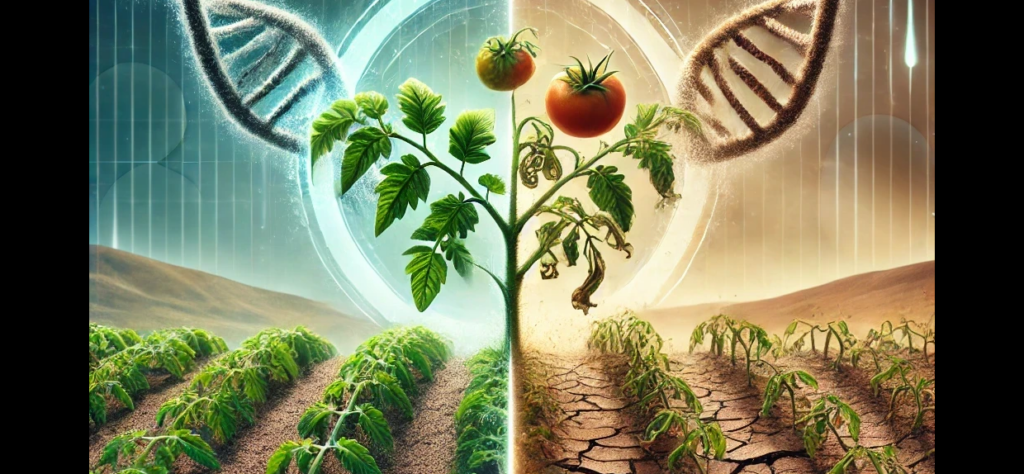
As climate change accelerates, understanding how crops survive environmental stress isn’t just an academic question—it’s a critical challenge for global food security. Tomatoes (Solanum lycopersicum), a staple crop worldwide, face increasing threats from drought, salinity, and extreme temperatures. But how do these plants adapt at the molecular level?
A recent study published in Scientific Reports investigated the evolutionary history, genomic diversity, and functional roles of protein phosphatase 2C (PP2C) genes in tomatoes (1). Instead of merely cataloging these genes, the researchers analyzed how PP2C gene expression changes under environmental stress. This information could help inform us about crop improvement strategies.
PP2C: A Key Player in Stress Response and More
PP2C enzymes act as molecular switches, regulating key signaling pathways involved in plant development as well as those that help plants survive harsh conditions. For example, they play an important role in the abscisic acid (ABA) signaling pathway, which helps plants conserve water during drought stress.
This study identified 95 S. lycopersicum PP2C (SlPP2C) genes in tomatoes, classifying them into 12 distinct subfamilies. The researchers also looked for expression levels of PP2C genes in plants at different stages of the life cycle and experiencing different stress scenarios. They found some genes showed strong upregulation under stress conditions.
But PP2C genes aren’t just stress regulators. Some genes are important plant development. In tomatoes, the researchers found that one gene, SlPP2C82, showed high expression in flowers, hinting at a role in reproductive success. Two other genes, SlPP2C67 and SlPP2C39, showed high expression levels during fruit development, suggesting that PP2Cs may influence yield and fruit quality.
Understanding these dual functions—stress resilience and developmental regulation—makes PP2Cs promising targets for genetic engineering and breeding programs aimed at sustaining tomato production in a changing climate.
Evolutionary Insights: How Did Tomato PP2C Genes Develop?
Evolutionary analysis revealed that tomato PP2C genes share a common ancestor with PP2Cs in Arabidopsis, Medicago, and rice. The researchers found that:
- 14 PP2C genes arose from segmental duplication events, a process that expands gene families and introduces functional diversity.
- There are no tandem duplications, which means that PP2Cs most likely evolved through large-scale chromosomal rearrangements rather than smaller, localized duplications.
These findings suggest that the expansion of PP2C genes played a key role in the adaptation of tomatoes to diverse environmental conditions.
Measuring PP2C Activity Under Stress
To move beyond gene expression data, the researchers also measured total PP2C enzyme activity under different abiotic stress conditions. They found SlPP2C activity increased significantly under drought, salinity and oxidative stress conditions. For drought stress, three genes, SlPP2C22, SlPP2C30 and SlPP2C52 showed strong upregulation suggesting that these genes play some role in helping plants mitigate water scarcity. In addition, the strongest upregulation occurred within 6–12 hours of stress exposure, indicating a rapid cellular response mechanism.
Looking to a Future With More Stress-Resilient Crops
While this study lays the groundwork for understanding PP2C’s role in stress response, many questions remain. Future research could explore gene knockout or CRISPR-based editing to further understand these genes role in stress resilience and fruit production. Comparative studies in other crops could also be used determine whether similar PP2C-driven stress mechanisms exist in other economically important plants.
By integrating comparative genomics, functional assays, and gene editing, researchers could develop tomato varieties that withstand climate extremes—a major step toward more resilient agriculture.
The Bottom Line
This study highlights the biological significance of PP2C genes in both stress resilience and plant development. As climate change continues to disrupt agriculture, unraveling these genetic mechanisms could lead to hardier, more productive crops. For plant scientists, molecular biologists, and agricultural researchers, these findings underscore the power of functional genomics in shaping the future of crop breeding.
Reference
- Sakib M. M., et al. (2024) Genomic identification, evolutionary analysis, and transcript profiling of protein phosphatase 2C in Solanum lycopersicum. Sci Rep. 14(1), 31742
Promega Products Used to Support This Research
SV Total RNA Isolation System
A membrane-based purification system that offers a fast and simple technique for isolating intact total RNA in as little as one hour.
GoScript™ Reverse Transcriptase
Offers reliable cDNA synthesis for sensitive expression detection.
